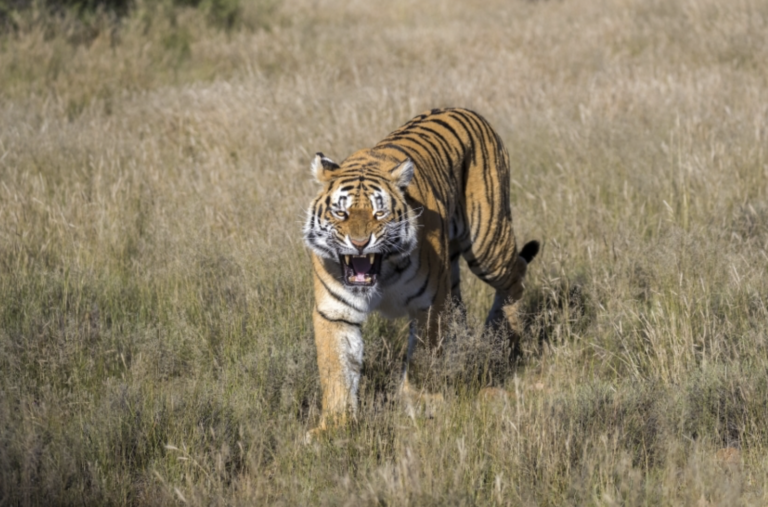For nearly a year, hundreds of researchers fanned out across Bhutan with one goal in mind: to find living examples of the endangered royal Bengal tiger. It was a massive scientific expedition that saw them survey more than 26,000 square kilometres of territory, or two-thirds of the country.
When researchers returned and tabulated their numbers last year, they were overjoyed.
Bhutan, it turned out, was home to 131 royal Bengal tigers, a 27 per cent jump from 2015.
The survey was conducted with support from the United Nations Environment Programme (UNEP) and was welcomed by conservationists, who have seen wild tiger numbers around the world plummet in recent decades.

The tiger is one of the world’s largest carnivores. It can weigh over 300 kilogrammes and reach up to 3.3 metres in length. This big cat once roamed Asia, from the eastern coast of Russia to the Caspian Sea.
However, since the beginning of the 20th century, an estimated 97 per cent of the world’s wild tigers have been lost. There are currently around 4,500 remaining in the wild across Asia, making the tiger an endangered species. The royal Bengal tiger is the most numerous tiger subspecies, making up about half the wild population.
Tigers are not the only animals facing an uncertain future. Biodiversity is deteriorating worldwide at rates unprecedented in human history. Around 1 million species are being pushed towards extinction, and 25 per cent of plant and animal groups are threatened.
The Kunming-Montreal Global Biodiversity Framework, which was adopted in 2022, aims to halt that decline through a set of four goals, composed of 23 targets to be achieved by 2030.

These goals include 30 per cent conservation of land, sea and inland waters, 30 per cent restoration of degraded ecosystems, and halving the introduction of invasive species.
The implementation of the framework is expected to be a key topic of discussion when leaders gather next month for the sixth session of the United Nations Environment Assembly (UNEA-6), the world’s top decision-making body on environmental matters.
“The extinction of the Royal Bengal Tiger would be a tragedy not just because of its stunning beauty and cultural significance. Losing these magnificent creatures would disrupt the finely balanced ecosystem and biodiversity of the region that has thrived for millennia.”
Room to roam
As one of the world’s largest carnivores, tigers need vast swaths of forest and grassland to roam, hunt and reproduce. Bhutan is a particularly important habitat. It provides a link between tiger populations in Nepal and northeast India, helping to keep genetic diversity strong.
However, human population growth across Asia and sprawling development has resulted in an ever-shrinking tiger habitat, threatening the cat’s survival.
A top predator, tigers play an important role in maintaining diverse and healthy ecosystems. They keep wild ungulates, such as pigs and sambar deer, under control, which preserves vegetation.
“The extinction of the Royal Bengal Tiger would be a tragedy, not just because of its stunning beauty and cultural significance,” says Doreen Lynn Robinson, Head of Biodiversity and Land at UNEP.
“Losing these magnificent creatures would disrupt the finely balanced ecosystem and biodiversity of a region that has thrived for millennia.”

Human-tiger conflict
Commercial logging, agricultural expansion and other development have eaten away at Asia’s grasslands, resulting in less food for the wild ungulates on which tigers prey. As these prey approach communities and their crops for easy meals, tigers too are venturing closer to villages to find food.
Since 2016, hundreds of cattle in Bhutan have been killed by tigers, causing economic hardship for subsistence farmers and villagers. “Human-tiger conflict has been on the rise, affecting residents in various regions of the country,” says Tashi Dhendup, Head of Bhutan Tiger Center. “While tigers are thriving, they seem to exhibit a significant reliance on livestock.”
Climate change is also putting tigers in peril. Bhutan is strongly affected by planetary warming like other mountainous countries in the Hindu Kush-Himalaya region.
As average temperatures rise, glaciers in the north of the country are retreating and heatwaves, wildfires and droughts are spreading. This is forcing tigers to move closer to human settlements to find prey and water.
Through the Vanishing Treasures programme, UNEP is supporting tiger conservation and helping to improve the wellbeing of people who live in proximity to the big cats. That work is being done alongside the Bhutan Tiger Center and the Department of Forest and Park Services, Royal Government of Bhutan.
The programme has helped villagers set up community pasturelands surrounded by solar-powered electric fences to protect livestock from tiger attacks. The fencing also shields crops from wild pigs, which can wipe out entire fields and attract tigers.
The Vanishing Treasures programme is funded by the Government of the Grand Duchy of Luxembourg. It has also focused on restoring grasslands, which are home to many ungulates on which tigers pray. Since 2019, around 93 hectares of grassland have been revived, resulting in improved hunting grounds for tigers and reducing human-tiger conflicts.

Through the Vanishing Treasures programme researchers have also installed camera traps across Bhutan. Hidden discreetly in forests and other habitats, the traps have snapped rarely seen images of tigers in the wild. That has helped researchers and park rangers identify individual animals, estimate population sizes and better understand how tigers use the landscape.
“The Vanishing Treasures project has played a pivotal role in addressing some of the challenges we encounter in tiger conservation,” says Dhendup. “The insights we are gaining from this project […] are proving instrumental in advancing our goal of fostering a harmonious coexistence between our communities and these magnificent big cats.”
The Vanishing Treasures programme is working with the Bhutan Tiger Center to use scat sampling or fecal dropping sampling to undertake a genetic analysis of tiger populations. The information gathered from this research has proved vital for charting tiger habitats, mapping genetic diversity, and understanding landscape changes caused by nature loss and climate change. The data contributed to Bhutan’s recent national tiger survey.
“With our partners in the Vanishing Treasures programme, UNEP is working to not only lessen the impacts of climate change on tiger populations but we are also helping communities to both find solutions to human-tiger conflict and strengthen their resilience to climate change,” says UNEP’s Robinson.
The sixth session of the United Nations Environment Assembly (UNEA-6) will be held from 26 February to 1 March 2024 at the UNEP headquarters in Nairobi, Kenya, under the theme: effective, inclusive and sustainable multilateral actions to tackle climate change, biodiversity loss and pollution. Through its resolutions and calls to action, the Assembly provides leadership and catalyzes intergovernmental action on the environment.
UNEP’s Vanishing Treasures programme, funded by the Government of the Grand Duchy of Luxembourg, aims to generate maximum synergy between climate change adaptation and biodiversity conservation by improving the adaptive capacity of mountain ecosystems while maintaining related ecosystem services, by protecting mountain flagship species that are key to ecosystem functioning and by promoting alternative livelihoods for local communities. In Bhutan, the Vanishing Treasure programme is implemented by the Bhutan Tiger Center in partnership with EURAC Research, the University of Natural Resources and Life Sciences, Vienna, and GRID-Arendal.
Source: UNEP NEWS




